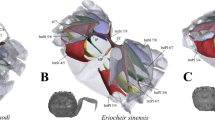Abstract
Expansion of the ‘pharynx’ during breathing or capturing prey in fishes generally involves posteroventral retraction of the hyoid arch. However, the hyoid arch structure of batoid fishes (skates, rays, guitarfishes, and sawfishes) is unique, and how they expand the pharyngeal cavity is poorly understood. To investigate the mechanism of pharyngeal expansion during breathing in the yellow-spotted fanray, Platyrhina tangi, we conducted anatomical and kinematic investigations of the pharyngeal region. Our study revealed that the yellow-spotted fanray and sharks have different skeletal linkage systems for pharyngeal expansion. During pharyngeal expansion in the yellow-spotted fanray, the hyoid bar and branchial apparatus rotate ventrally around the hinge joint between the fifth ceratobranchial cartilage and the pectoral girdle. This pharyngeal expansion mechanism appears to be widespread among batoid fishes and is unique among cartilaginous fishes (sharks, batoids, and holocephalans). Batoid fishes possibly developed this pharyngeal expansion mechanism during early batoid evolution.







Similar content being viewed by others
References
Brainerd EL, Ferry-Graham LA (2006) Mechanics of respiratory pumps. In: Shanwick RE, Lauder GV (eds) Fish biomechanics. Elsevier Academic Press, London, pp 1–28
Carrier JC, Murru FL, Walsh MT, Pratt HL Jr (2003) Assessing reproductive potential and gestation in nurse sharks (Ginglymostoma cirratum) using ultrasonography and endoscopy: an example of bridging the gap between field research and captive studies. Zool Biol 22:179–187
Compagno LJV (1977) Phyletic relationship of living sharks and rays. Am Zool 17:303–322
Dean MN, Motta PJ (2004a) Feeding behavior and kinematics of the lesser electric ray, Narcine brasiliensis (Elasmobranchii: Batoidea). Zoology 107:171–189
Dean MN, Motta PJ (2004b) Anatomy and functional morphology of the feeding apparatus of the lesser electric ray, Narcine brasiliensis (Elasmobranchii: Batoidea). J Morphol 262:462–483
Douady CJ, Dosay M, Shivji MS, Stanhope MJ (2003) Molecular phylogenetic evidence refuting the hypothesis of Batoidea (rays and skates) as derived sharks. Mol Phyogenet Evol 26:215–221
Hughes GM (1960) The mechanism of gill ventilation in the dogfish and skate. J Exp Biol 37:11–27
Hughes GM, Ballintijn CM (1965) The muscular basis of the respiratory pumps in the dogfish (Scyliorhinus canicula). J Exp Biol 43:363–383
Lauder GV (1983) Food capture. In: Webb PW, Weihs D (eds) Fish biomechanics. CBS Educational and Professional Publishing, New York, pp 280–311
Liem KF, Summers AP (1999) Muscular system. In: Hamlett WC (ed) Sharks, skates, and rays. The Johns Hopkins University Press, Baltimore and London, pp 93–114
McEachran JD, Dunn KA, Miyake T (1996) Interrelationships of the batoid fishes (Chondrichthyes, Batoidea). In: Stiassny MLJ, Parenti LR, Johnson GD (eds) Interrelationships of fishes. Academic Press, New York, pp 63–84
Miyake T, McEachran JD (1991) The morphology and evolution of the ventral gill arch skeleton in batoid fishes (Chondrichthyes: Batoidea). Zool J Linn Soc 102:75–100
Miyake T, McEachran TLD, Hall BK (1992) Edgeworth’s legacy of cranial muscle development with an analysis of muscles in the ventral gill arch region of batoid fishes (Chondrichthyes: Batoidea). J Morphol 212:213–256
Motta PJ (2004) Prey capture behavior and feeding mechanics of elasmobranchs. In: Carrier JC, Musick JA, Heithaus MR (eds) Biology of sharks and their relatives. CRC Press, Boca Raton, pp p165–p202
Motta PJ, Wilga CD (1999) Anatomy of the feeding apparatus of the nurse shark, Ginglymostoma cirratum. J Morphol 241:33–60
Nishida K (1990) Phylogeny of the suborder Myliobatidoidei. Mem Fac Fish Hokkaido Univ 37:1–108
Romer AS (1985) The vertebrate body. Holt Rinehart & Winston, Austin
Shirai S (1992) Squalean phylogeny. Hokkaido University Press, Sapporo
Shirai S (1996) Interrelationships of the living neoselachians (Chondrichthyes: Neoselachii). In: Stiassny MLJ, Parenti LR, Johnson GD (eds) Interrelationships of fishes. Academic Press, New York, pp 9–34
Summers AP, Ferry-Graham LA (2001) Ventilatory modes and mechanics of the hedgehog skate (Leucoraja erinacea): testing the continuous flow model. J Exp Biol 204:1577–1587
Summers AP, Ketcham RA, Rowe T (2004) Structure and function of the horn shark (Heterodontus francisci) cranium through ontogeny: development of a hard prey specialist. J Morphol 260:1–12
Westneat MW (2006) Skull biomechanics and suction feeding in fishes. In: Shanwick RE, Lauder GV (eds) Fish biomechanics. Elsevier Academic Press, London, pp 29–75
Whittamore JM, Bloomer C, Hanna GM, McCarthy ID (2010) Evaluating ultrasonography as a non-lethal method for the assessment of maturity in oviparous elasmobranchs. Mar Biol 157:2613–2624
Wilga CD (2010) Hyoid and pharyngeal arch function during ventilation and feeding in elasmobranchs: conservation and modification in function. J Appl Ichthyol 26:162–166
Wilga CD, Motta PJ (1998) Feeding mechanism of the Atlantic guitarfish Rhinobatos lentiginosus: modulation of kinematic and motor activity. J Exp Biol 201:3167–3184
Wilga CD, Wainwright PC, Motta PJ (2000) Evolution of jaw depression mechanics in aquatic vertebrates: insight from Chondrichthyes. Biol J Linn Soc 71:165–185
Wu EH (1994) Kinematic analysis of jaw protrusion in orectolobiform sharks: a new mechanism for jaw protrusion in elasmobranchs. J Morphol 222:175–190
Acknowledgments
TT was supported by a scholarship from the Japan Society for the Promotion of Science (Japan). We thank the following for providing data and specimens: Keiichi Ueda, Rui Matsumoto, Ikue Hamasaki, and other members of the staff at the Okinawa Churaumi Aquarium. We also thank Toshio Kawai, Mamoru Yabe, Hisashi Imamura, and other HUMZ members at Hokkaido University for providing the dead specimens. Isao Sarashina and Keisuke Shimizu provided access to freeze drying equipment at the University of Tokyo. We also thank Peter Wainwright, Ryosuke Motani (University of California Davis), and one anonymous reviewer for improving the manuscript.
Author information
Authors and Affiliations
Corresponding author
Additional information
Communicated by A. Schmidt-Rhaesa.
Rights and permissions
About this article
Cite this article
Tomita, T., Toda, M., Yamamoto, Y. et al. A novel pharyngeal expansion mechanism in the yellow-spotted fanray, Platyrhina tangi (Elasmobranchii: Batoidea), with special reference to the function of the fifth ceratobranchial cartilage in batoids. Zoomorphology 132, 317–324 (2013). https://doi.org/10.1007/s00435-012-0185-9
Received:
Revised:
Accepted:
Published:
Issue Date:
DOI: https://doi.org/10.1007/s00435-012-0185-9




